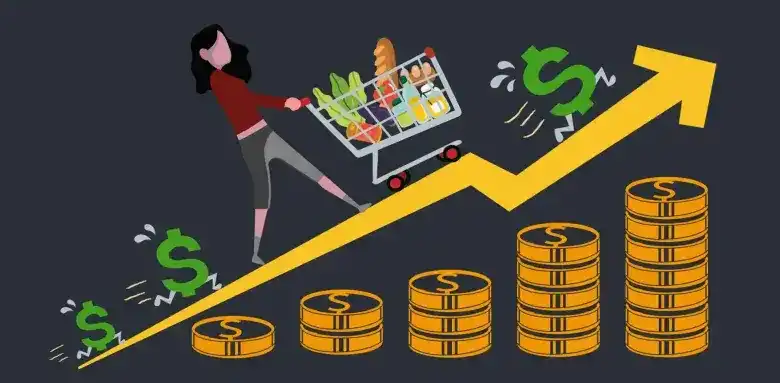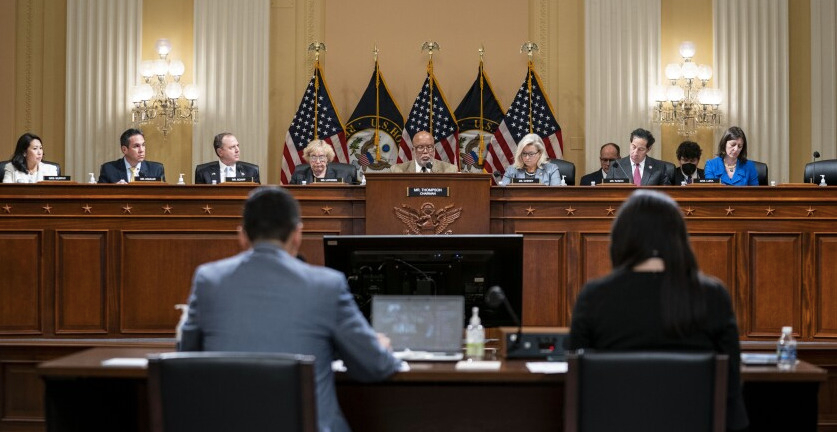Will prices come down anytime soon?

Image: CBC
Late last week, a gas station in Rancho Cordova, CA, was overwhelmed with customers after a glitch caused prices to drop for several hours to 69 cents per gallon… on the date 6/9 (nice).
But the humorous coincidence also shows how many Americans are eager to pounce on low gas prices, as the US average climbed above $5 per gallon over the weekend for the first time in history. (For comparison, the previous all-time record before this year was $4.11/gallon, set in July 2008.)
📈 And it’s not just gas prices… US inflation saw its fastest annual growth since 1981 in May (+8.6%), per the most recent Consumer Price Index published Friday.
- Some of the biggest month-to-month increases were seen in fuel oil (+16.9%), airfares (+12.6%), dairy products (2.9%), and used cars and trucks (+1.8%).
💬 What they’re saying: A recent JPMorgan report predicted US gas prices “could surge another 37% by August to a $6.20/gal national average.”
- Separately, top executives at JPMorgan, Morgan Stanley, and Goldman Sachs have warned of an economic shake-up in the coming months and years due to a series of ‘unprecedented’ factors.
👀 Looking ahead… The Fed is expected to raise interest rates by 0.5% after its next two meetings, the first of which occurs this week. Rates are currently in the range of 0.75%–1%.
See the 360° view: Will prices come down anytime soon? →

Sprinkles from the Left
- Some commentators on the Left argue that, with a little luck, inflationary pressures should subsist at least by this time next year, as the pandemic’s effects are further diminished and sanctions against Russia become less harsh to Western economies.
- Others contend that the Fed should be shouldering the brunt of the blame for the current inflation crisis, as there isn't much Democratic lawmakers can actually do – though the situation will likely persist through midterms and end up costing the incumbent party.
“The persistence of high inflation in the US has been a surprise, certainly to me. But so too has been the ongoing pandemic — the vaccines that became available more than a year ago still have not ended it. And a Russian invasion was barely on the radar screen when troops crossed the Ukraine border earlier this year.
Indeed, the quickly rising prices are due mostly to badly scrambled global supplies resulting from the ongoing pandemic and war in Ukraine, and much will depend on how these two shocks play out. Yet while predicting the course of events from here is intrepid, there are reasons to be optimistic. I'm confident that inflation will be meaningfully lower by this time next year and back to something we will feel comfortable with not too long thereafter…
The pandemic appears to be winding down… Each wave has been less disruptive to the economy than the one that preceded it. The virus is becoming less virulent, our vaccines and therapies more effective, and our economy's ability to manage around the virus is improving.
Further, the worst of the economic fallout from Russia's aggression also appears at hand… Any country that is going to sanction Russian oil has likely now done so, and other global oil producers have strong economic incentives to produce more, which they have announced they'd do. Oil prices, and thus gasoline prices, should decline later this year…
Legislation isn't necessary for my optimistic inflation outlook to come to pass. Now all we need is a bit of good fortune and for the pandemic and Russia's invasion of Ukraine to take a turn for the better.”
“As the midterm elections draw nearer, a central conservative narrative is coming into sharp focus: President Joe Biden and the Democratic-controlled Congress have a made a mess of the American economy. Republicans see pure political gold in this year’s slow-motion stock market crash, which seems to be accelerating at the perfect time for a party seeking to regain control of Congress in the fall…
But the narrative pinning blame for the economy’s woes squarely on Democrats’ shoulders elides the true culprit: the Federal Reserve. The financial earthquakes of 2022 trace their origin to underground pressures the Fed has been steadily creating for a over a decade…
The Fed has steadily inflated stock prices over the last decade by keeping interest rates extremely low and buying up bonds — through a program called quantitative easing — which has the effect of pushing new cash into asset markets and driving up prices. The Fed then supercharged those stock prices after the pandemic meltdown of 2020 by pumping trillions into the banking system. It was the Fed that primarily dropped the ball on addressing inflation in 2021, missing the opportunity to act quickly and effectively…
And while the Fed is a prime driver of this year’s volatility, the central bank continues to evade public accountability for it… Just last month, for instance, the Senate confirmed Mr. Powell to serve another four-year term as Fed chairman. The vote — more than four to one in favor — reflects the amazingly high level of bipartisan support that Mr. Powell enjoys…
This leaves the field open for the Republican Party to pin the blame for Wall Street’s woes on the Democratic Party’s inaction.”

Sprinkles from the Right
- Some commentators on the Right argue the US is headed for a stagflation crisis due to the progressive Left’s trillions in spending bills passed in recent years, which were intended to help most Americans but actually ended up hurting them.
- Others contend that the standard of living for millions of Americans is about to suffer, since the Fed’s only option to deal with limited supply is to cut demand at all costs – meaning high interest rates and high joblessness.
“What progressive spending gave to Americans in welfare and new entitlements, it has taken away in a lower standard of living…
Economists who claimed inflation was transitory and driven by increases in select categories such as used cars are belatedly admitting they were wrong. What else can they do? Prices for some goods have moderated in recent months, but inflation is broadening. That’s why the so-called core inflation index that excludes energy and food is up 6% over the past 12 months and 0.6% from April…
A historically tight labor market has pushed up nominal wages, but worker pay isn’t keeping up with prices. Real average hourly wages have fallen 3% over the last year, with two-thirds of that decline in the last four months.
One lesson is that progressive welfare spending and expanded child-tax credits in the name of aiding workers contributed to inflation that erased the value of those benefits. Workers would be far better off now if Congress hadn’t passed $2.8 trillion in Covid “relief” in late 2020 and early 2021. The federal government has $6.7 trillion more debt than before the pandemic, and inflation isn’t abating.
Once inflation sets in, it acquires its own momentum and isn’t easy to break. The personal savings rate in April fell to 4.4%, the lowest since September 2008, as consumers spend more on almost everything. Inflation has battered consumer economic confidence, and one risk is that it will cause Americans to reduce purchases and slow the economy…
Democrats owe West Virginia Sen. Joe Manchin thanks for saving them from worse inflation had they passed $4.5 trillion in Build Back Better spending. The May report ought to kill BBB’s last desperate vestiges.”
“The Fed would like inflation to average around 2% per year, but that’s impossible when the cost of just one item—shelter — is pushing the CPI up 2.4% per year…
The Fed is trying to reduce demand for these items by raising interest rates, but it’s hard to see how that will work. On the margin, people can cut back. They can buy cheaper items at the grocery store, or squeeze another year’s life out of the old truck, or move in with a friend, but they’ll still need to eat and have a roof over their heads and heat the house and get to work. These are necessities, not luxuries.
Prices are rising for these items not because demand for them has suddenly surged, but because the supply has been constrained…
Raising interest rates won’t increase the supply of any of these necessities. In fact, raising interest rates reduces the supply of houses and other produced goods and services…
For the most part, inflation is being caused by shortages of supply, not excesses of demand. But the only way the central banks can bring supply and demand back into balance is to destroy demand by any means necessary.
In practice, that means millions of people around the world will be required to lose their jobs. But I thought the problem was a shortage of workers…
What does this mean for you and me and the millions starving in Africa? A lower standard of living.”
Share this!
Recent Discussion stories

Discussion
| June 10, 2022The Jan. 6 committee’s first public hearing
🏛️ The House select committee investigating the Jan. 6, 2021, attack on the US Capitol held its first of six public hearings in a prime-time session last night.

Discussion
| June 8, 2022The solutions for combating gun violence
🇺🇸 Today, we’re covering various policies and technologies that have been proposed or enacted in recent weeks to curb gun violence in American communities.

Discussion
| June 6, 2022The Xinjiang Police Files
🇨🇳 A human rights group recently published hacked Chinese police files representing one of the most extensive public accounts of Beijing’s treatment of its mostly Muslim Uyghur population.
You've made it this far...
Let's make our relationship official, no 💍 or elaborate proposal required. Learn and stay entertained, for free.👇
All of our news is 100% free and you can unsubscribe anytime; the quiz takes ~10 seconds to complete